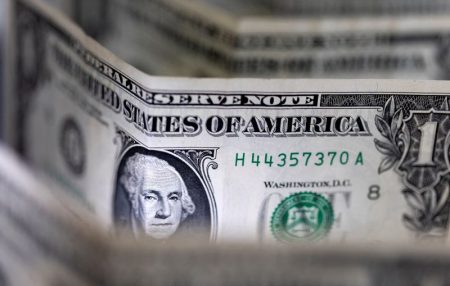By Alun John and Kevin Buckland
LONDON (Reuters) – The dollar gave back the previous day’s advances against the euro and pound but held some gains against the yen on Tuesday as traders’ attention turned to U.S. inflation data due on Wednesday for signs of how close U.S. rates are to peaking.
The euro was up 0.4% at $1.0903 and the pound was up 0.5% at $1.2439 as most European markets returned from the long Easter weekend.
Both currencies over the break had slipped from their early April peaks after resilient U.S. labour market released Friday bolstered the case for a Federal Reserve rate hike next month, and also eased fears about a sharper slowdown in the U.S. economy.
“The Fed’s early May meeting is beginning to loom and the data on the way to that is very much the focus,” said Jane Foley, head of FX strategy at Rabobank.
She said the euro’s ability to jump clear of $1.09 would depend on the upcoming data and what it meant for U.S. interest rates.
“Bank earnings will also be important, they don’t often reach across to FX markets directly, but they might given the recent jitters,” Foley added.
Tuesday’s moves were also affected by European markets’ reopening after the break, said Simon Harvey, head of FX analysis at Monex Europe, given the limited liquidity on Friday and Monday with most European markets closed.
He said algorithms trading currencies based on the difference between European and U.S. rates might have sold euros for dollars when U.S. Treasury yields rose after the jobs data while European bond markets were closed.
European bond yields rose sharply on Tuesday catching up after the break. [GVD/EUR]
“There’s just that catch up effect flushing through,” Harvey said.
The dollar also slid against the Japanese yen dropping 0.4% to 133.09, having jumped 1.1% on Monday helped by new Bank of Japan Governor Kazuo Ueda, who vowed to stick with ultra-easy stimulus settings at his inauguration on Monday.
Traders now see roughly a two-thirds chance the Fed will raise rates by another quarter point on May 3, according to the CME’s Fedwatch tool.
The dollar also softened elsewhere, dropping 0.58% against the Swiss franc to 0.9042, and also weakened against the Australian dollar, with the up 0.42% to $0.667, helped by a amid a thawing of trade tensions with China, as the pair agreed to end a dispute over Australian barley.
touched a fresh 10-month high at $30,438 on Tuesday before last fetching $30,140, after breaking free of recent ranges on Monday.
The digital token had been stuck between about $26,500 and $29,400 for the previous three weeks.
Read the full article here















